Necessity of Business Manners
Business manner is the basic necessity in-order to work smoothly in a society or a workplace environment. So if the foundation of business manner is strong, trust with others can be built easily leading to a good workplace environment. If a person is highly skilled it doesn’t mean that he/she will be assigned a job or project immediately, only after the foundation of trust is built he will be assigned a proper job. The trust factor here comes from a proper display of business manner which is based on the human skills like pro-activeness, judgemental power and expressiveness. The main thing expected out of a person in the business world is maintaining good people relations which is dependent upon the expressiveness of the person ,i.e, proper judgement of situations and proactively reacting to it.
So, in Japan a person who has gained the trust and has sufficient skill set will be called a true professional or a capable business man.
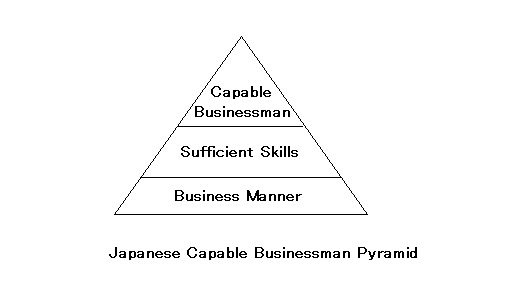
Important requirements for a working professional
Relationship
Good relationships start with good people skills,i.e, how well you collaborate, communicate and deal with conflict.
There are several characteristics that make up good, healthy working relationship:
・Trust
This is the foundation of every good relationship. When you trust your team and colleagues, you form a powerful bond that helps you to work and communicate more effectively. If you trust the people you work with, you can be open and honest in your thoughts and actions, and you don’t have to waste time and energy “watching your back.”
・Mutual Respect
When you respect the people who you work with, you value their input and ideas, and they value yours. Working together, you can develop solutions based on your collective insight, wisdom and creativity.
・Mindfulness
This means taking responsibility for your words and actions. Those who are mindful are careful and attend to what they say, and they don’t let their own negative emotions impact the people around them.
・Open Communication
We communicate all day, whether we’re sending emails and IMs, or meeting face to face. The better and more effectively you communicate with those around you, the richer your relationships will be. All good relationships depend on open, honest communication.
Understanding Business manner is about knowing the ‘activity model’ of social ethics or people relationship. Here, one needs to identify the morals and associated people relations with one’s heart. It is most important to connect the heart with human relationships which forms the core of business manner understanding. The word heart refers to concern and consideration.
Find below a couple of examples related to right attitude w.r.t human relationship and applying heart w.r.t human relationship:
1) No matter how close a person is to his colleague or senior at workplace, he needs to behave with the basic workplace etiquette in mind.
2) A newly appointed manager regarding whom there is negative feedback from various sources, should not be dealt with based one others feedback but with one’s viewpoint.
Manner
This is one of the basics of good business manner. To be considerate and have concern towards your subordinates and superiors. When this thoughtful behavior reverberates in your coworker’s heart it leads to smooth interactions and a pleasant working environment.Also the considerate nature always reflects in one’s bowing posture,business card exchange or in other behavioral attitude towards a client. So we can conclude that, when considerate nature reflects in a form or posture we have business manner put into practice.
Find below few examples of various instances which can be referred to as basic skills or core values of business manners in Japan:
・Greeting Manners
- Greeting everyone with a loud voice in the mornings when one enters the office.
- When leaving office in the evening one needs to wish the senior who is still working.
・Posture Manners
The three basic postures are shown in the figure below:
- Eshaku – The body is bent 15 degrees in this posture and used to greet a subordinate or senior in the office in the morning and evening. Also can be a used as a casual way of greeting anyone at office in a day.
- Keirei – The best situation to use this posture of bending the body 30 degrees is after introducing ourselves during customer visits.
- Sai-keirei – The best case of using this posture of bending the body 45 degrees is while seeing off the customers which expresses gratitude.

・Manners when going out on a client Visit
- The appointment date and time should be prioritized as per client need.
- When client enters the meeting room, one needs to getup from one’s seat and greet. Later on introduce self(in case of first meeting) and hand over the business card followed by the Keirei posture.In case of receiving the business card as well the same flow should be followed ending with the Sai-keirei posture which shows deep gratitude towards the client.
・Manners when client visits us
- In case of guiding client inside an elevator, one needs to enter first and press the open button and destination floor button and guide the client inside. However in cases wherein there are people already inside the elevator, one needs to hold the door with one hand and guide the client inside first and later enter. While getting off the elevator one needs to press the open button and guide the client outside first and later move out of the elevator.
- It is a good practice to knock the door of meeting room before entering. Also in case of door which opens on the inside of the room one needs to enter first and invite the clients inside. However in case of door which opens outside, one needs to hold the door and show the client inside first and later enter the room.
・Seating Manners
Seating manners are also too important in Japanese business. Refer to the various instances as displayed in the below figure.
The Senior most person will be given the seat farthest from the door in a meeting room while the junior most will be seated near to the door. In case of a taxi, senior most employee will be given the seat behind the driver while the junior most employee will be seated on the passenger seat next to the driver. In a train or aeroplane, senior most person will be given the seat next to the window in the direction of motion. Finally the position in a elevator will be behind the junior most person who will operate the panel. The 1,2,3,4,5 numbers in the below picture refer to the employees from the senior most to the junior most position in the order.
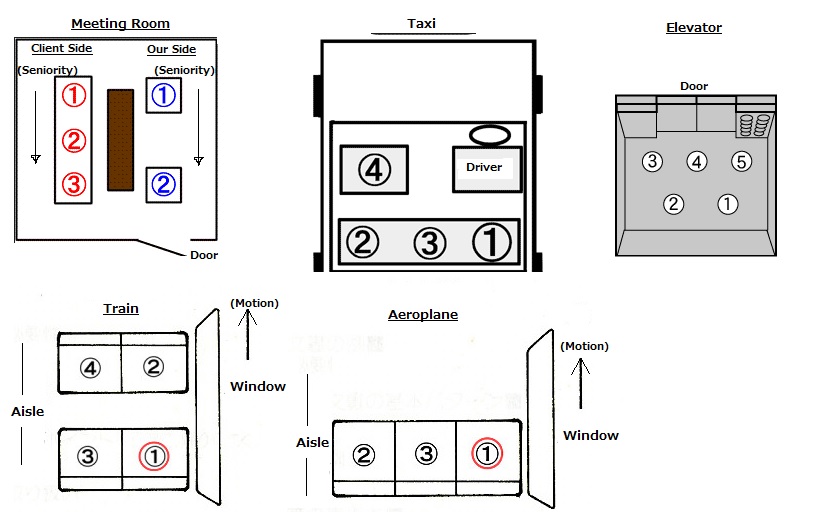
Communication style
All good relationships are dependent on how much we respect the other person’s thinking or values and his position. This considerate nature is the starting step in building a satisfactory communication.Lets get to know more about the considerate nature communication style used to connect with people.
Understanding the connection between communication style and relationships
“To make or mar depends on the telling” is the translation of a famous Japanese proverb. This simply means that, people may or may not get offended by the way you speak and mentioning “i didn’t mean that” might be too late to say once one is offended. However, if one is considerate and gentle towards others feelings even the unsaid things can be understood leading to a communication style which touches the other person’s heart. This considerate nature improves people relationships resulting in strong bonds and high efficiency within teams at workplace.
- Points to be taken care of when listening to others
1) Make agreeable responses in order to make the person feel at ease
2) Look the person in eye while making the agreeable response
3) Listen to the person till the end of his conversation without interrupting - Points to be taken care of when talking to others
1) Use respectful words as much as possible even while speaking to a colleague or coworker
2) When asked about a topic which one is not well versed about, avoid creating false impressions and convey your true knowledge
3) Do not deny a person’s opinion outright.
Knowledge of the basic Keigo/ Honorifics
Keigo is the verbal expression of one’s respect towards the other person’s position or standpoint. We can say that keigo is the basic human skill required because incase our respect towards a person doesn’t match in words there is an imbalance which needs to be addressed to with high priority. There are some rules to use the Keigo which we will learn in this section.
Keigo consists of following types, which uses different expressions for different situations;
- Honorific language (Sonkeigo)
Sonkeigo, or the respectful form, is used to show respect to someone of higher position. This can be somebody in the same company of higher rank or a client for example. - Humble language (Kenjougo)
When referring to him or herself in business, the Japanese will use a form called Kenjougo.The form essentially tries to show respect by deliberately referring to oneself lower than the listener (who typically are of higher rank or position). - Polite language (Teineigo)
Teineigo is perhaps the easiest and the most commonly used by everybody (including native Japanese speakers). This is because the Teineigo is usually the first form of Keigo that is taught to students learning the Japanese language.
Below picture gives a pictorial representation of the above forms;
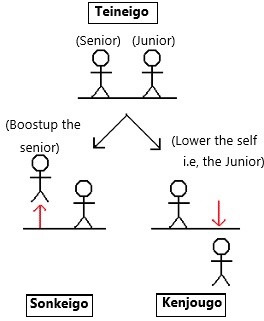
Refer below the Keigo list of various verbs;

Basic knowledge of situation based communication style
A true professional or a capable business person chooses different communication style for situations like reporting or explanation, requests, trouble resolution etc. The main motive here is the same as point number one above ,i.e, relating communication style to relationships. Planning of communication techniques based on positive response from the audience in-order to develop good relationships.
・Reporting
The purpose of reporting is to provide information. There are various types here like business reporting, management reporting, office reporting etc. The basic idea in all the reporting types is to communicate the information as it is in a simple and understandable way. The main point here is to start from the conclusion or summary and elaborate on that thereby giving priority to the superior’s time. This is the true quality of a considerate business person.
・Explanation
The purpose of explanation is to make the audience understand your point. Instances like explanation of new features of a product to the customer, explaining one’s point of view in a meeting, explaining the work procedure to one’s team etc are a few cases which requires explanation from a business perspective. The important thing here is to use simple words and be specific so that the other party can understand your viewpoint easily.
・Requesting
Where every one in the team is involved in their routine work, in addition to that if we need cooperation from the team on another task at hand we need to make a request. The way to request is, first ask about the status of the current work and express one’s understanding regarding the same.On top of that explain about the new task on hand and check the team’s co-operation on get involved.So the gist is to first understand the other person’s current status and get a frank reply regarding cooperation on the new task at hand. This is the way to make a request in-order for the other party to get involved wholeheartedly.
・Grievance Redressal
Whenever there are claims or complaints from the clients, first thing is to accept it and take the responsibility. The next important thing is to rebuild the confidence of one’s organization by wiping off the distrust factor. This is the main purpose behind grievance redressal. In most of the cases whenever there is a complaint we can see people replying as “not a problem with our product” or put the blame on handling the product etc. Here the first thing is to apologize followed by expression of gratitude towards instructions from the customer. By this way of communication we are trying to rebuild the confidence of customer w.r.t our company.
Socializing activities
Of the many socializing activities of a business person in Japan greeting colleagues and customers during end and start of the year, wining and dining with the customers, sending gifts to seniors to express gratitude, thanking a person who was of help are some of the instances during which consideration towards the other person are expressed.
The socializing activities mentioned here are w.r.t to work or business. Hence the person representing the company will be required to show a dignified behavior or business manner. The polite greeting towards the end or start of the year, hospitality shown through corporate entertainment, the gratitude shown by sending summer gifts(chuugen) or winter gifts(seibo) to seniors, the words of concern expressed during visit to a sick coworker or client are all dignified ways of showing one’s heartfelt considerate nature.
Other necessary skills
Information handling
Information gathering, organizing and communicating form the main components of business information cycle. Information here comprises of vital data which may be used for business related activities. The motto of information handling is to have fast access to precise information.
Though clients are the main source of information, we have occasions like business get together parties and pan-industry social events wherein important information can be gathered w.r.t to new business etc. The business manner to be displayed here is to listen patiently to the person providing information in-order to extract the precise information which we want.
The main intention behind organizing information is easy and quick access when needed. Information like business cards, sales or development documents etc are vital data relating to business, when handled properly is a proof that one is seriously involved in one’s work. Also the information managed by us should not be limited to us but must be actively utilized by all concerned in-order to maximize the gains. So organizing of information is vital.
Communicating the actual information in a proper way is of prime importance. The information provided here should be of value to the customer as well. Hence the routine gathering and organizing of information is vital to sharing the needed information to the customer. Also the information limited to us will be of little value when compared to information shared within the team thereby increasing the efficiency of the team. Information like business related documents, problem points etc can be of real help to anyone in the team.
Document management
It is common at workplace to communicate information in writing when the same can be done through a call like an order or notice. The reason behind this can be thought of as to keep a record of transactions, to communicate the point precisely, to communicate the information to multiple people at a time etc.
Communication in writing,i.e, documentation can be broadly divided into internal and external documents.The internal documentation or the document circulated within the company should prioritize on the efficiency aspect rather than politeness. Whereas an external document to be sent to a client should follow a specific format and must consist of polite words. Here we are following a writing format which keeps the recipient in high esteem.
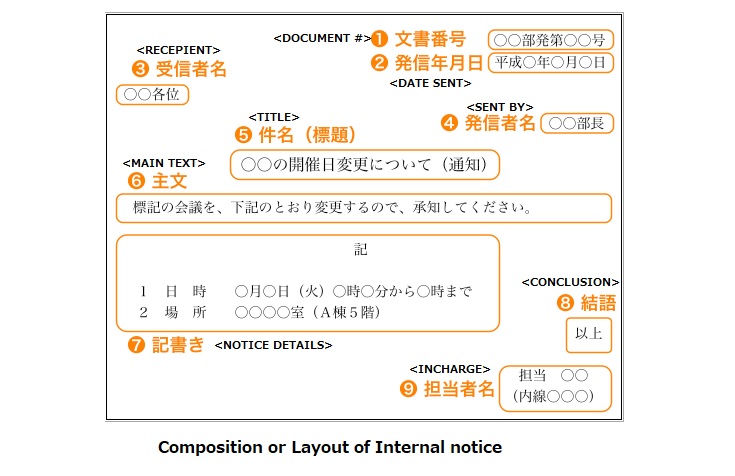
The format above shows the layout of an internal document like a notice and the below format picture depicts an external document like a letter sent to a client.
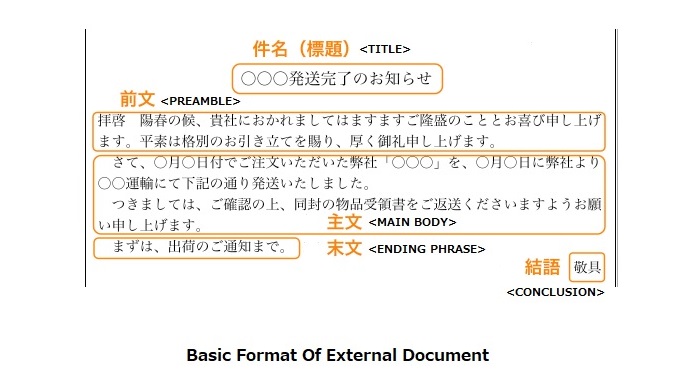
One more section which falls under this section of necessary skill is meetings, regarding which we had discussed earlier in the situation based communication style and seating manners part.
To sum it up, i have tried my maximum to write in simple words regarding workplace practices expected out of a professional in Japan. I hope you find it useful!
Sources :
ビジナス実務マナー検定 受験ガイド(Business Practice Manner Test Guidebook), Work Experience

Leave a Reply